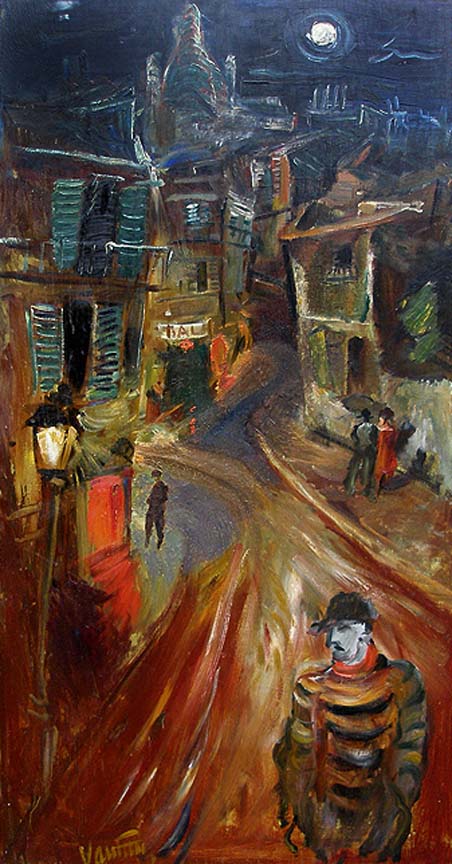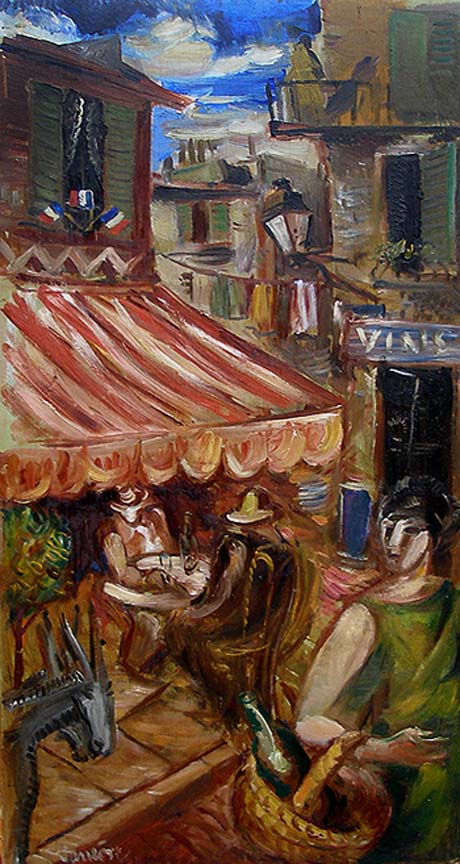



MOGENS VANTORE
"NIGHT AND DAY"
PAIR, OIL ON PANEL, EACH SIGNED
DANISH, WORKED IN PARIS, C.1925
35 X 19 INCHES EACH
1895 – 1977 Eric Mogens Christian Vantore was born March 16, 1895 to Danish parents in Copenhagen, Denmark where he was also raised. His father, painter Hans Christian Vantore (1861-1928), studied under P.S. Kroyer and Lauritz Tuxen who were both central figures in the Skagen Plein Air School, the most influential art movement in Denmark at the time. Mogens’ mother was the daughter of the well known French art dealer P.B. Le Fleure. With this artistic background Mogens was in contact with many well known artists of the time and so became motivated to paint at an early age. At 14, he started formal training at the Technical School in Copenhagen where he was inspired by the Impressionist School, mainly Gauguin, Van Gogh and Cezanne. His strong palette of greens, yellows and blues was to become the signature of Vantore’s work and only rarely do we see him straying from this boldness of colour. Vantore’s first exhibition was in 1912 at the age of 17 when he exhibited 25 landscapes and portraits. The young Vantore was successful during these early years and the press gave him exceptional mention, with especially high praise for his portraits. In 1923 Vantore moved to France with his first wife and settled close to Paris in Nogent Sur Marne, in the house in which the French painter Watteau once lived. Only a few of Vantore’s paintings from this period made it back to Denmark as they were quickly sold in Paris. Upon his return to Denmark in 1925 Vantore became an uncensored exhibitor at the Carlottenborg Exhibitions (Royal Danish Academy) and spent most of his time in Copenhagen. Vantore’s wife died in 1930. He remarried in 1932 to Nanna and during the following years painted with a new inner strength inspired by their vibrant relationship. Escaping the hectic Bohemian life of Copenhagen and Paris, the couple settled in the central part of Jylland in the village of Roe where Vantore found himself in a quieter work mode. It was in this atmosphere of country space that Vantore painted a great number of landscapes. Vantore was never a “landscape” painter in the typical sense; his paintings are more in the manner of the Impressionist plein air painters. He always tried to depict his inner relationship with his surroundings, inspired by the flavour of the local people who gave the landscape life and atmosphere. Vantore always sought to balance his art not only by his superb craftsmanship, but also through his colours and artistic insight. From Vantore’s Jylland period we also see beautiful, revealing portraits and still lifes. In these paintings he returns to the simplicity of earlier pieces. During the latter part of his life he moved to a small village just north of Copenhagen and travelled frequently to Spain where he painted some very refreshing and airy works. Vantore felt a strong personal contact with his paintings; he tried to look inside himself and capture his feelings in order to convey these onto canvas and therefore onto the viewer. Right up to his death at 82 Vantore painted some of his finest and strongest works.
|